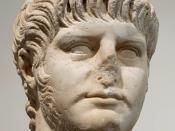The death of Claudius in 54 A.D., was thought to have been planned and carried out by his wife Agrippina Minor. She wanted to secure the title as emperor for her adopted son, Lucius Domitius Ahenobarbus. Before his death, Claudius, though he already had a son named Britannicus, he adopted Lucius, who later changed his name to Nero Claudius Caesar. On Claudius's death, the praetorian guards, under their perfect Sextus Afranius Burrus, Agrippina's agent, declared Nero emperor at the age of 17.
The early part of his reign was characterized by direction from these older figures, including Agrippina herself. Some saw a struggle between Agrippina against Seneca and Burrus for control of the young emperor, and when Agrippina began to show favoritism toward Britannicus, his murder was arranged (55 A.D.) and Agrippina's authority displaced. In 59 he had his mother put to death for her criticism of his mistress, Poppaea Sabina.
In 62 he divorced and later executed his wife, Octavia, and ended up marring Poppaea.
Nero, by then clearly deranged, continued to reign for nine gruesome years. The reign of Nero saw the confirmation of the Roman dominion in Britain, by the campaigns of Suetonius Paulinus in Wales and by the crushing of the great revolt of the Iceni in the eastern area under their queen Boadicea.
All four Julio-Claudian emperors lived in the shadow of Augustus, and none felt secure on his throne. Insecurity brought tyranny, which then provoked conspiracies in the Senate and in the palace. Finally, even the army turned away from the dynasty that had created the empire. Nero was the last of the Julio-Claudian emperors. Nero was already a disliked emperor. It did not help that he was an insecure emperor just like the other four Julio- Claudian emperors, this brought much despise...



Needs organisation.
I don't understand why, in this history of Rome,it starts not at 753BC with its origin but at 54 AD, ignoring completely the Republic and start of the Imperial system. In fact you only write (very scantily) about TWO emperors! And you wrote very little for anyone to get anything fromthis info you present, making it less useful as an essay than a visit to Wikepedia.
1 out of 4 people found this comment useful.